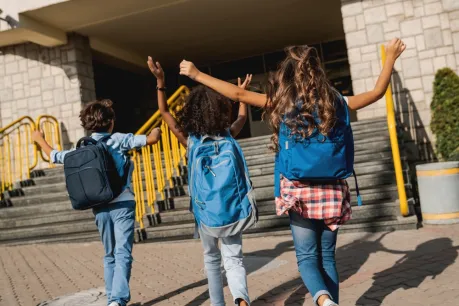How to Talk to Your Kids About Getting to School Safely

Key Takeaways
- From walking to riding the bus, every school commute comes with its own set of risks. Teaching your child simple safety rules early can prevent serious accidents later.
- Encourage alert, distraction-free habits; refrain from using phones while walking, biking, or driving. Modeling good behavior as a parent is the strongest lesson of all.
- Even when kids follow the rules, accidents can happen due to careless drivers or unsafe school zones. Quick reporting and documentation make all the difference.
- If your child is hurt because someone else failed to act responsibly, Morgan & Morgan can help your family seek justice and hold negligent parties accountable.
Injured?
Back-to-school season is full of big conversations: class schedules, supplies, and first-day jitters. But one of the most important talks you can have with your child isn’t about what happens in school, but how they’re getting to and from it. Whether they’re riding the bus, walking, biking, driving, or carpooling, every school commute comes with potential hazards, and the best way to protect your child is to talk to them about safety before they hit the road.
You may assume these are “common sense” rules, but kids don’t automatically know how to navigate traffic safely; it has to be taught. These conversations don’t need to be scary. Experts recommend skipping the horror stories and instead offering clear guidance, modeling good habits, and praising your child when they follow safe practices.
School Bus Safety: It's More Than Just a Ride
School buses are statistically among the safest means of transportation for children. Still, the area around the bus can be incredibly hazardous, especially for younger children who are smaller and more difficult for drivers to see.
To help keep your kids safe, teach them the following:
- Always stay at least six feet away from the curb while waiting for the bus, which is about three big steps.
- Never walk directly behind or in front of the bus unless absolutely necessary. If they must cross the street in front of the bus, they should walk 10 feet ahead and make sure they can see the driver, and the driver can see them.
- Get on and off quickly and safely. No pushing, playing, or lingering near the doors.
Safe Walking Habits: Heads Up, Phones Down
If your child walks to school, they need to understand that being a pedestrian comes with real responsibility. Streets are busy, drivers are distracted, and small missteps can have serious consequences.
Here are some walking safety basics to go over:
- Always use sidewalks when available.
- If no sidewalk exists, walk facing traffic, as far from the road as possible.
- Only cross the street at crosswalks or intersections, and never assume a car will stop, even if your child has the light.
- Teach them to make eye contact with drivers before crossing in front of a vehicle.
- No phones or headphones while walking, especially near intersections or driveways. They need to be able to see and hear what’s happening around them.
Biking to School: More Than Just a Helmet
Biking can be a fun, independent way for kids to get to school, but only if they understand the rules of the road. Before letting your child cycle solo, do a few practice runs together and go over these essentials:
- Always ride with traffic, not against it.
- Stay in a single file line, especially if riding with others.
- Stop completely at intersections and walk the bike across.
- Never use headphones while riding; alertness is key.
- Always wear a properly fitted helmet, and consider wearing bright or reflective clothing to enhance visibility.
Driving to School: A Big Milestone Comes With Big Responsibility
If your teen has just passed their driving test, congratulations (and take a deep breath)! The first year behind the wheel is the most dangerous for new drivers, so consistent guidance is critical.
Here’s how to help your teen stay safe:
- Continue practicing with them, even after they’ve earned their license. Ride along and give gentle feedback on changing road conditions, construction zones, or tricky intersections near school.
- Be the driver you want them to become; that means no texting, speeding, or aggressive maneuvers.
- Ensure they know exactly what to do in the event of an accident.
What to Do If There’s an Accident
Even with the best planning and habits, accidents can happen. Whether your child is walking, biking, driving, or riding the bus, they must know what steps to take in the aftermath:
- Stay calm and check for injuries. If anyone is seriously hurt, call 911 immediately.
- Get to a safe location, away from traffic if possible.
- Call a parent or guardian right away so they can assist or arrive at the scene.
- If your teen is driving, ensure they know to exchange information with the other driver, including name, insurance details, and license plate number, and take photos of the damage and the surrounding area.
- Report the incident to the school if it happened during transit to or from campus.
- Seek medical attention, even if injuries seem minor at first. Some symptoms take time to appear.
For parents, it’s essential to document everything and keep a copy of any police report or witness statements. If someone else caused the accident, you may be entitled to seek compensation for medical bills, missed school, and more, and that’s when an experienced injury attorney can help.
Reminders for the Adults: Carpool and Drop-Off Smarts
Whether you’re the daily drop-off hero or helping out another parent, adults need to model safe driving behavior during the school rush. That includes:
- Putting the phone away, no exceptions.
- Driving extra cautiously in school zones and near crosswalks.
- Never pass a stopped school bus. The 10 feet around the bus is a danger zone for children.
- Following the school’s designated drop-off and pick-up procedures, they’re designed for flow and safety.
When Safety Fails, We’re Here
No matter how many precautions you take, accidents can still happen, especially when others behave recklessly. If your child is injured due to someone else’s negligence, whether in a school zone crash, pedestrian incident, or while biking to school, you don’t have to handle it alone.
Morgan & Morgan is the nation’s largest injury law firm, with the resources and experience to stand up for families. We fight for justice for victims of car accidents and school zone negligence.
For over 35 years, we’ve been helping families move forward after the unthinkable. Because for us, it’s not just about legal cases; it’s about protecting what matters most.

We've got your back
Injured?
Not sure what to do next?
We'll guide you through everything you need to know.

